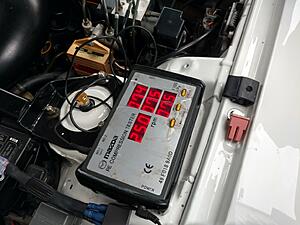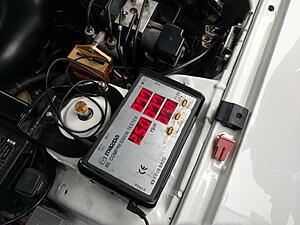What is the normal deterioration of compression on a 13B-REW?
#1
Senior Member
Thread Starter
What is the normal deterioration of compression on a 13B-REW?
Just a curious question that I have as I just had my car compression tested today prior to updating my map for water injection and a shade over 15 PSI on the stock fuel system (with a 12v feed to the pump) and the last time it was compression tested was 2.5 years, c.5,0000-6,000 miles and 4 track days ago. I know my results are really good so I'm not worried about the car at all but the new results are lower than they were 2.5 years ago so I got to thinking about what the typical deterioration level is for relatively stock cars (i.e. stock or small street port, Mazda OEM apex seals, twins, etc.)
Is there a specific expectation say every 5,000 or 10,000 miles? Assuming there are no ancillary issues or detonation problems along the way.
Also, what is the speed of the OEM starter as mine cranks at 260 RPM and I thought they were lower than that on FD's.
My car when I tested it 2.5 years ago had the following results following it's import from Japan (this is how the motor came, I never rebuilt it and don't know who did it in Japan or if it ever was rebuilt although logic says it must have been at some point):
2.5 years ago:
Front rotor: 7.6, 7.6, 7.7 bar (110.2, 110.2, 111.7 PSI)
Rear rotor: 8.0, 8.0, 8.0 (116, 116, 116 PSI)
Today:
Front rotor: 7.4, 7.5, 7.5 bar (107.4, 108.8, 108.8 PSI)
Rear rotor: 7.7, 7.7, 7.8 (111.7, 111.7, 113.1 PSI)


Is there a specific expectation say every 5,000 or 10,000 miles? Assuming there are no ancillary issues or detonation problems along the way.
Also, what is the speed of the OEM starter as mine cranks at 260 RPM and I thought they were lower than that on FD's.
My car when I tested it 2.5 years ago had the following results following it's import from Japan (this is how the motor came, I never rebuilt it and don't know who did it in Japan or if it ever was rebuilt although logic says it must have been at some point):
2.5 years ago:
Front rotor: 7.6, 7.6, 7.7 bar (110.2, 110.2, 111.7 PSI)
Rear rotor: 8.0, 8.0, 8.0 (116, 116, 116 PSI)
Today:
Front rotor: 7.4, 7.5, 7.5 bar (107.4, 108.8, 108.8 PSI)
Rear rotor: 7.7, 7.7, 7.8 (111.7, 111.7, 113.1 PSI)


Last edited by cib24; 10-07-17 at 11:46 AM.
#2
Your readings are within 3% of last time so I'm not sure you can call this verified degradation of compression. Consider the compensation factors. An Excel tool that I made for this is here.
https://drive.google.com/open?id=0Bz...Ul3QXNQaWk2cTA
First is cranking speed compensation. The Mazda tool is going to make that compensation for you.
Cranking speed compensation:
Take the measured psi and increases by 0.22041 for every rpm below 250
Take the measured psi and decreases by 0.22041 for every rpm above 250
The next is compensation for ambient pressure. I don't think the Mazda tool accounts for this but I could be wrong. Mazda accounts for this is in the service manual using an altitude formula, but altitude is a reflection of differing ambient pressure. If you have a stormy day with a bit lower pressure, that's like running at higher altitude. Similarly, if it's a sunny high pressure day it's like running at lower altitude. Weather isn't a huge contributor by any means, but we are splitting hairs over a 3 or 4% difference, so at that point it could account for some of the difference.
Was the engine compression tested at the same altitude/location for both tests? Altitude compensation:
Take the cranking speed corrected psi and increases by 0.0028 psi for every 1 foot of altitude
The other thing to consider is the degradation of the instrument. Was the tester calibrated since then?
https://drive.google.com/open?id=0Bz...Ul3QXNQaWk2cTA
First is cranking speed compensation. The Mazda tool is going to make that compensation for you.
Cranking speed compensation:
Take the measured psi and increases by 0.22041 for every rpm below 250
Take the measured psi and decreases by 0.22041 for every rpm above 250
The next is compensation for ambient pressure. I don't think the Mazda tool accounts for this but I could be wrong. Mazda accounts for this is in the service manual using an altitude formula, but altitude is a reflection of differing ambient pressure. If you have a stormy day with a bit lower pressure, that's like running at higher altitude. Similarly, if it's a sunny high pressure day it's like running at lower altitude. Weather isn't a huge contributor by any means, but we are splitting hairs over a 3 or 4% difference, so at that point it could account for some of the difference.
Was the engine compression tested at the same altitude/location for both tests? Altitude compensation:
Take the cranking speed corrected psi and increases by 0.0028 psi for every 1 foot of altitude
The other thing to consider is the degradation of the instrument. Was the tester calibrated since then?
#3
Senior Member
Thread Starter
Thanks. Yes, I know my compression is very good and hopefully the motor will last a long time.
That's a really useful link and also thank you for pointing out that the atmosphere makes a difference.
It was not tested at the same location but it is in the UK and I have just checked the the location the first time was at an elevation of about 78 meters (c.257 feet) and the location this past weekend was 66m (215 feet), so not material. The test 2.5 years ago was done in May on a sunny day and it was I'm guessing about 60-65 F looking at my photos and what everyone was wearing. This weekend it was cloudy and sprinkling on occasion and about 50-55 F. So, overall not much difference but I guess enough to be within that 3% margin of error you are talking about.
Still, the engine no doubt has worn at least a bit and I was just curious what you would typically expect to see every 10,000 miles in terms of a compression drop. It must be very rare to ever see exactly the same or very close to the same figures as you would most likely see lower numbers each time you went.
That's a really useful link and also thank you for pointing out that the atmosphere makes a difference.
It was not tested at the same location but it is in the UK and I have just checked the the location the first time was at an elevation of about 78 meters (c.257 feet) and the location this past weekend was 66m (215 feet), so not material. The test 2.5 years ago was done in May on a sunny day and it was I'm guessing about 60-65 F looking at my photos and what everyone was wearing. This weekend it was cloudy and sprinkling on occasion and about 50-55 F. So, overall not much difference but I guess enough to be within that 3% margin of error you are talking about.
Still, the engine no doubt has worn at least a bit and I was just curious what you would typically expect to see every 10,000 miles in terms of a compression drop. It must be very rare to ever see exactly the same or very close to the same figures as you would most likely see lower numbers each time you went.
#4
Somebody at Mazda has durability test data showing engine compression vs engine hours on whatever engine dyno durability schedule they run. I haven't seen anything published in English about that though. And that testing was done almost 30 years ago I bet, so it's sitting in an archive or it's been destroyed.
are you using the same tester now as you did two years ago? And has it been calibrated? I don't even know what the calibration schedule is for a Mazda tester, but from my experience you need to do regular calibrations of pressure transducers to maintain the kind of accuracy you are trying to deal with. The Mazda tool is good but it's still designed to judge whether the engine is within a very broad spec. It's not designed to track degradation. It's a service tool, not an R&D lab grade tool.
if it weren't a hassle I would say, check compression once a week for a month, making sure to record barometric pressure each time. Then you have 5 samples and could do some statistical analysis.
are you using the same tester now as you did two years ago? And has it been calibrated? I don't even know what the calibration schedule is for a Mazda tester, but from my experience you need to do regular calibrations of pressure transducers to maintain the kind of accuracy you are trying to deal with. The Mazda tool is good but it's still designed to judge whether the engine is within a very broad spec. It's not designed to track degradation. It's a service tool, not an R&D lab grade tool.
if it weren't a hassle I would say, check compression once a week for a month, making sure to record barometric pressure each time. Then you have 5 samples and could do some statistical analysis.
Last edited by arghx; 10-09-17 at 07:32 PM.
#6
Racecar - Formula 2000
Unless the compression is so low it won't start...which is the way the 1st gen's usually died.

